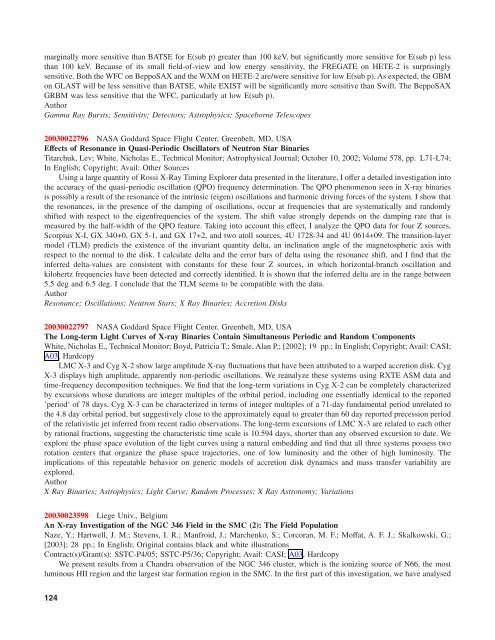Create successful ePaper yourself
Turn your PDF publications into a flip-book with our unique Google optimized e-Paper software.
marginally more sensitive than BATSE for E(sub p) greater than 100 keV, but significantly more sensitive for E(sub p) less<br />
than 100 keV. Because of its small field-of-view and low energy sensitivity, the FREGATE on HETE-2 is surprisingly<br />
sensitive. Both the WFC on BeppoSAX and the WXM on HETE-2 are/were sensitive for low E(sub p). As expected, the GBM<br />
on GLAST will be less sensitive than BATSE, while EXIST will be significantly more sensitive than Swift. The BeppoSAX<br />
GRBM was less sensitive that the WFC, particularly at low E(sub p).<br />
Author<br />
Gamma Ray Bursts; Sensitivity; Detectors; Astrophysics; Spaceborne Telescopes<br />
20030022796 NASA Goddard Space Flight Center, Greenbelt, MD, USA<br />
Effects of Resonance in Quasi-Periodic Oscillators of Neutron Star Binaries<br />
Titarchuk, Lev; White, Nicholas E., Technical Monitor; Astrophysical Journal; October 10, 2002; Volume 578, pp. L71-L74;<br />
In English; Copyright; Avail: Other Sources<br />
Using a large quantity of Rossi X-Ray Timing Explorer data presented in the literature, I offer a detailed investigation into<br />
the accuracy of the quasi-periodic oscillation (QPO) frequency determination. The QPO phenomenon seen in X-ray binaries<br />
is possibly a result of the resonance of the intrinsic (eigen) oscillations and harmonic driving forces of the system. I show that<br />
the resonances, in the presence of the damping of oscillations, occur at frequencies that are systematically and randomly<br />
shifted with respect to the eigenfrequencies of the system. The shift value strongly depends on the damping rate that is<br />
measured by the half-width of the QPO feature. Taking into account this effect, I analyze the QPO data for four Z sources,<br />
Scorpius X-I, GX 340+0, GX 5-1, and GX 17+2, and two atoll sources, 4U 1728-34 and 4U 0614+09. The transition-layer<br />
model (TLM) predicts the existence of the invariant quantity delta, an inclination angle of the magnetospheric axis with<br />
respect to the normal to the disk. I calculate delta and the error bars of delta using the resonance shift, and I find that the<br />
inferred delta-values are consistent with constants for these four Z sources, in which horizontal-branch oscillation and<br />
kilohertz frequencies have been detected and correctly identified. It is shown that the inferred delta are in the range between<br />
5.5 deg and 6.5 deg. I conclude that the TLM seems to be compatible with the data.<br />
Author<br />
Resonance; Oscillations; Neutron Stars; X Ray Binaries; Accretion Disks<br />
20030022797 NASA Goddard Space Flight Center, Greenbelt, MD, USA<br />
The Long-term Light Curves of X-ray Binaries Contain Simultaneous Periodic and Random Components<br />
White, Nicholas E., Technical Monitor; Boyd, Patricia T.; Smale, Alan P.; [2002]; 19 pp.; In English; Copyright; Avail: CASI;<br />
A03, Hardcopy<br />
LMC X-3 and Cyg X-2 show large amplitude X-ray fluctuations that have been attributed to a warped accretion disk. Cyg<br />
X-3 displays high amplitude, apparently non-periodic oscillations. We reanalyze these systems using RXTE ASM data and<br />
time-frequency decomposition techniques. We find that the long-term variations in Cyg X-2 can be completely characterized<br />
by excursions whose durations are integer multiples of the orbital period, including one essentially identical to the reported<br />
’period‘ of 78 days. Cyg X-3 can be characterized in terms of integer multiples of a 71-day fundamental period unrelated to<br />
the 4.8 day orbital period, but suggestively close to the approximately equal to greater than 60 day reported precession period<br />
of the relativistic jet inferred from recent radio observations. The long-term excursions of LMC X-3 are related to each other<br />
by rational fractions, suggesting the characteristic time scale is 10.594 days, shorter than any observed excursion to date. We<br />
explore the phase space evolution of the light curves using a natural embedding and find that all three systems possess two<br />
rotation centers that organize the phase space trajectories, one of low luminosity and the other of high luminosity. The<br />
implications of this repeatable behavior on generic models of accretion disk dynamics and mass transfer variability are<br />
explored.<br />
Author<br />
X Ray Binaries; Astrophysics; Light Curve; Random Processes; X Ray Astronomy; Variations<br />
20030023598 Liege Univ., Belgium<br />
An X-ray Investigation of the NGC 346 Field in the SMC (2): The Field Population<br />
Naze, Y.; Hartwell, J. M.; Stevens, I. R.; Manfroid, J.; Marchenko, S.; Corcoran, M. F.; Moffat, A. F. J.; Skalkowski, G.;<br />
[2003]; 28 pp.; In English; Original contains black and white illustrations<br />
Contract(s)/Grant(s): SSTC-P4/05; SSTC-P5/36; Copyright; Avail: CASI; A03, Hardcopy<br />
We present results from a Chandra observation of the NGC 346 cluster, which is the ionizing source of N66, the most<br />
luminous HII region and the largest <strong>star</strong> formation region in the SMC. In the first part of this investigation, we have analysed<br />
124
















